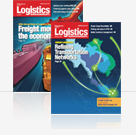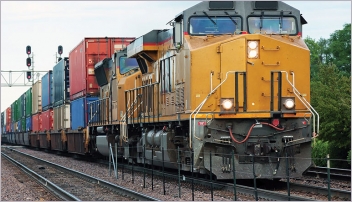Pearson on Excellence: Lighting a sustainable supply chain fire under suppliers
A growing number of manufacturing companies are warming up to sustainability—taking aggressive steps to soften and shrink their environmental footprints. However, buy-in from those companies’ suppliers has been less encouraging.
Logistics in the News
Intermodal volume declines continue in November, reports IANA Lower demand and volumes drive down FedEx fiscal second quarter earnings Truck tonnage trends down in October, reports American Trucking Associations AAR and STB offer differing views on two final adopted final rules DOT issues NOFO for $1.5 billion in RAISE grants program More Logistics NewsLogistics Resource
31st Annual Study of Logistics and Transportation Trends Broken, stressed, strained, and out of sync. All have been featured in recent headlines describing the condition of logistics and supply chain operations.
Broken, stressed, strained, and out of sync. All have been featured in recent headlines describing the condition of logistics and supply chain operations.All Resources
A growing number of manufacturing companies are warming up to sustainability—taking aggressive steps to soften and shrink their environmental footprints. However, buy-in from those companies’ suppliers has been less encouraging.
These insights come from research coordinated by theCarbon Disclosure Project (CDP), a UK-based organization that works with companies to document greenhouse gas emissions. According to CDP, 34 percent of its member companies have established absolute and intensity-based emission reduction targets. However, only 5 percent of the suppliers that serve CDP member companies have enacted such targets. Nearly 40 percent of suppliers working with CDP companies have nosustainabilityprograms whatsoever.
What can companies do to stimulate suppliers’ commitment to ecologically responsible practices? And why is it in their best interests to do so? In the aforementioned report, CDP offers some ideas.
The most important incentive related insight, elegant in its simplicity, may be that “suppliers listen to their customers.” According to CDP, 55 percent of suppliers that received more than three requests to participate in asupply chainsustainability program made emissions reductions. Among suppliers receiving just one request, the acquiescence rate was 26 percent. Financial benefits tracked closely to this frequency-of-request pattern: The more responses, the more environmental and economic benefits.
Suppliers may also respond to preferential treatment. For example, a buyer might incentivize sustainability performance by favoring a supplier that delivers on a particular sustainability metric. CDP notes the good example set by Vodafone Group Plc, which allocates shares of business to approved suppliers based on a sustainability scorecard the latter must fill out.
Companies can also engage suppliers by helping align risk management programs. Currently, 94 percent of CDP member companies integrate climate issues into company-wide risk management processes, compared with only 51 percent of suppliers. Clearly, it’s in everyone’s best interests to get a solid handle on risks that could lead to business interruption.
Another angle of persuasion is finding common ground. As part of its research, CDP identified a disconnect between the types of collaboration deemed most effective by suppliers and the types of collaboration pursued by CDP member companies. Suppliers tend to focus on process and product design changes to drive emission reductions. However, the most favored investments made by CDP member companies are behavioral change initiatives and transportation and fleet-management investments.
Naturally it pays to accentuate the benefits that sustainability related collaborations can generate. According to CDP, companies that engage with multiple suppliers greatly increase their chances of benefiting financially from an emissions reduction program. Consider Cisco, which reduced greenhouse emissions by 41 percent compared to a 2007 baseline. One of the effort’s cornerstones was collaborating with supply chain partners and involving industry consortia to develop common reporting and auditing tools. Here are some other success stories:
Coca-Cola works with its bottlers to identify financially beneficial emission-reduction initiatives. From 2004 to 2011, Coca-Cola achieved close to $900 million in savings, predominantly from investments in energy efficiency.
Working closely with contract footwear manufacturers, Nike’s Manufacturing Energy & Carbon Program achieved a 6 percent absolute reduction in CO2e (equivalent carbon dioxide) in four years, despite a 20 percent increase in production.
PepsiCo’s Tropicana brand worked with farmers to develop carbon neutral fertilizers using orange rinds that are a byproduct of orange juice processing.
- Wal-Mart has been working with MeadWestvaco (MWV) to develop a more environmentally efficient package for the former’s retail pharmaceutical adherence business. The new package is up to 80 percent more greenhouse-gas efficient to develop and reduces transportation costs and emissions. The result for MWV’s key retail customers will be greenhouse gas emission savings of more than 12,000 metric tons annually.
According to one of Wal-Mart’s suppliers, “Wal-Mart has driven our efforts to become sustainable and has made us aware of many areas where we can make a difference. Wal-Mart’s interest in reducing their own carbon footprint pushed our company to consider all initiatives in order to be a more responsible supplier.”
In one sense, this supplier is simply acknowledging what all companies should know: Sustainability is good business, and the more a company collaborates with its suppliers and business partners, the more “good business” gets done.

About the Author
Mark PearsonMark Pearson is the managing director of the Accenture’s Supply Chain Management practice. He has worked in supply chain for more than 20 years and has extensive international experience, particularly in Europe, Asia and Russia. Based in Munich, Mark can be reached at[email protected]
Subscribe to Logistics Management Magazine!
Subscribe today. It's FREE!Get timely insider information that you can use to better manage your entire logistics operation.
Start your FREE subscription today!
 Compliance Risk: A Significant Impediment to the Modern Supply Chain
A comprehensive guide to compliance risks and pitfalls for modern supply chains.
Download Today!
Compliance Risk: A Significant Impediment to the Modern Supply Chain
A comprehensive guide to compliance risks and pitfalls for modern supply chains.
Download Today!
 It has been a very volatile year, complicated by general political and economic instability around the globe. For logistics and supply chain professionals and carrier executives, it’s time to respond and build a coherent, cohesive, flexible and resilient strategy in the face of rapid and continuous change.
It has been a very volatile year, complicated by general political and economic instability around the globe. For logistics and supply chain professionals and carrier executives, it’s time to respond and build a coherent, cohesive, flexible and resilient strategy in the face of rapid and continuous change.并购的妈妈entum: 2022 Top 20 Warehouses Truckload: Easing back to normal? View More From this Issue
 How companies need to evolve to achieve Supply Chain Resiliency
Join our webinar, hosted by Adrian Wood from Dassault Systèmes, to learn about the key requirements and considerations in the supply chain resiliency evolution.
Register Today!
How companies need to evolve to achieve Supply Chain Resiliency
Join our webinar, hosted by Adrian Wood from Dassault Systèmes, to learn about the key requirements and considerations in the supply chain resiliency evolution.
Register Today!








